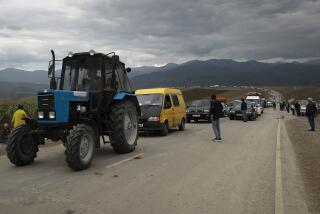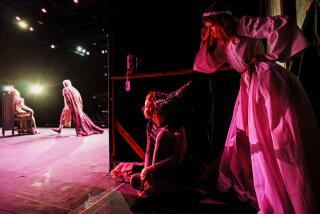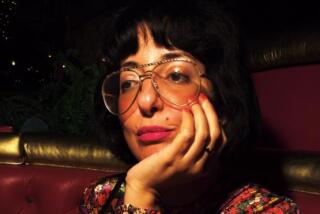‘Armenians’ Has Universal, Specific Themes
I know my name ends in “ian.” But please don’t discount me as another overly proud Armenian who was annoyed at Laurie Winer’s “Nine Armenians” review (“ ‘Armenians’ Is Generic Despite Trappings,” Calendar, July 25).
I am a full-time playwright and screenwriter, as well as an Armenian. I understand the challenges of writing a good play that is also culturally relevant. So I was able to approach “Nine Armenians” as both a dramatic and a cultural work. I believe it succeeds on both counts.
Dramatically, the play flows with a linguistic, aural and scenic rhythm that brings the theater alive. It unwinds with the grace of an old storyteller, gathering people around to entertain. While the through-line of the play curves here and there like a good yarn, instead of screaming forward like a bullet, it is all-encompassing in detailing the modern-day challenges of a family and the secrets of that family’s history.
Sometimes, yes, the facts about the Armenian Genocide of 1915 are explicitly pronounced. But that is no more “preachy,” than, say, Anna Deavere Smith’s inclusion of Hasidic Jewish and African American cultural factoids and details surrounding the Crown Heights incident in “Fires in the Mirror.” The audience--especially the non-Armenian audience--needs a context to be able to tap into the play and its historic pulse.
Sure the play could use work. Maybe it is a little sugary. Also, having been to Armenia, I would have liked to see daughter Ani’s episode in Armenia fleshed out a little more--to see her interacting with more people, rather than recounting her activities in letters.
But that does not mean that what is presented about Armenia is vague: We learn, without didacticism, that children in orphanages draw black suns out of fear; there are three hours of electricity a day; people are struggling to make ends meet; the ghost of the Armenian Genocide is eerily present in the current war and blockades; people still go to church and sing and dance; and that Mt. Ararat, though in modern-day Turkey, is still an inspiration to Armenians.
Furthermore, what Winer sees as undeveloped characters are in fact subtle ensemble characters who do not always allow themselves to acknowledge certain issues. As in life, it is difficult to let the true feelings, the secrets, the anger come out. That intentional “silence” or mysteriousness in certain scenes shouldn’t be misinterpreted as “vagueness” of character.
I have been closely in touch with the Armenian community to gauge their response to the play. They have their criticisms here and there--mostly about facts, Armenian word usage and smaller issues. But none of these people--most of whom lived through the specific struggles of genocide, discrimination and emigration--have considered the play “generic.”
The fact is that the play’s family and issues are universal. They apply to any family with a strong culture needing to reconcile with their past. I’ve seen the play several times now, mostly with non-Armenians. And they all felt that they were seeing, to some extent, their own families portrayed.
As a cultural experience, “Nine Armenians” is a landmark piece of theater, the first modern play about Armenians to get a mainstream audience in America.
Perhaps if Armenian American theater were encouraged a little more, as other cultural theater is, more plays could possibly emerge that are even stronger in illuminating the Armenian American experience to modern audiences.
“Nine Armenians,” however, is a tough act to follow. The audience, from all backgrounds, seems to be embracing it. And after one performance I heard a subscriber, who was clearly not Armenian, say that “Nine Armenians” was “one of the best plays I’ve seen at the Taper.”
That is what counts.
More to Read
The biggest entertainment stories
Get our big stories about Hollywood, film, television, music, arts, culture and more right in your inbox as soon as they publish.
You may occasionally receive promotional content from the Los Angeles Times.










